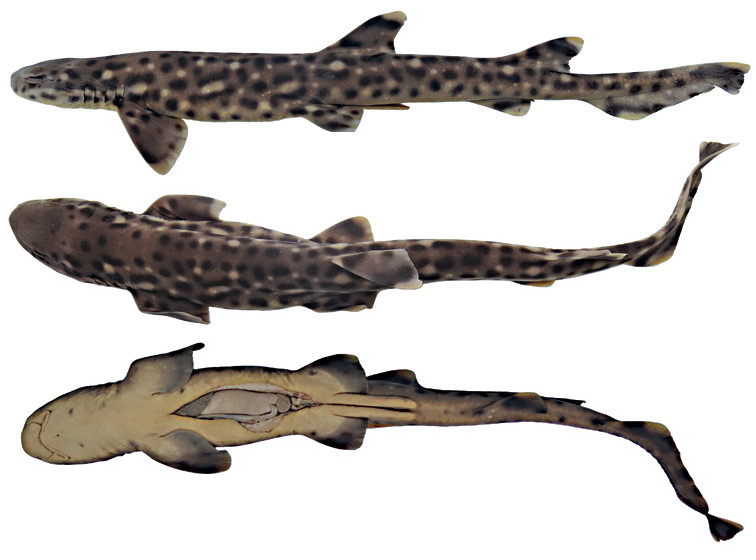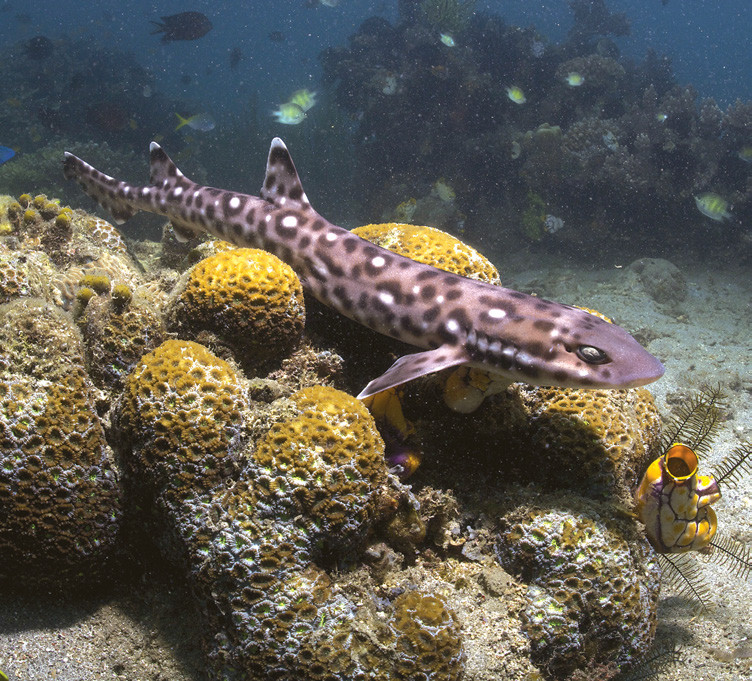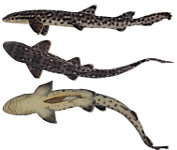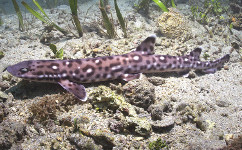Atelomycterus erdmanni
Fahmi & White, 2015
Classification: Elasmobranchii Carcharhiniformes Scyliorhinidae
Reference of the original description
Atelomycterus erdmanni, a new species of catshark (Scyliorhinidae: Carcharhiniformes) from Indonesia. Journal of the Ocean Science Foundation, 14, 14–27
Atelomycterus erdmanni, a new species of catshark (Scyliorhinidae: Carcharhiniformes) from Indonesia. Journal of the Ocean Science Foundation, 14, 14–27
Image of the original description

Atelomycterus erdmanni Fahmi & White, 2015, holotype, adult male 501 mm TL (NCIP 6544), lateral view, dorsal view, ventral view © FAHMI, Research Centre for Oceanography, Indonesian Institute of Sciences & WILLIAM T. White, CSIRO Oceans & Atmosphere Flagship, National Research Collections of Australia

Atelomycterus erdmanni Fahmi & White, 2015, holotype, adult male 501 mm TL (NCIP 6544), lateral view, dorsal view, ventral view © FAHMI, Research Centre for Oceanography, Indonesian Institute of Sciences & WILLIAM T. White, CSIRO Oceans & Atmosphere Flagship, National Research Collections of Australia
Description :
Citation: Atelomycterus erdmanni Fahmi & White, 2015: In: Database of modern sharks, rays and chimaeras, www.shark-references.com, World Wide Web electronic publication, Version 12/2025
Please send your images of "Atelomycterus erdmanni" to info@shark-references.com

Atelomycterus erdmanni Fahmi & White, 2015, © Lembeh Strait, Indonesia, underwater photograph on coral by M.V. Erdmann

Atelomycterus erdmanni Fahmi & White, 2015, © Lembeh Strait, Indonesia, underwater photograph on coral by M.V. Erdmann
Common names
 Spotted-belly Catshark
Spotted-belly Catshark
 Spotted-belly Catshark
Spotted-belly Catshark
Short Description
Orignal diagnosis of FAHMI & WHITE, 2015 [22223]: A medium-sized Atelomycterus species (to at least 508 mm TL) with the following combination of characters: a relatively short snout, 3.4–3.8% TL; head length 17.5–17.9% TL; precaudal length 76.6–79.1% TL; interdorsal space 13.4–13.7% TL; distance between pectoral and pelvic fins and pelvic to anal fins about equal, ratio of pectoral-pelvic and pelvic-anal 1.01–1.02; anal-fin length to anal-fin base ratio 1.29; dorsal fins moderately falcate, posterior margins sloping anteroventrally from fin apices; denticles strongly tricuspid with an elongate medial cusp; claspers of adult males relatively short, outer length 9% TL, clasper base width 15.5% of clasper outer length, not stubby, not tapering from base to tip; clasper glans extending about half of clasper outer length; cover rhipidion relatively narrow; rhipidion moderately large, partly concealed by cover rhipidion and exorhipidion; pseudosiphon about half length of cover rhipidion; clasper tip narrow and bluntly pointed. Colour pattern consisting of dark brown to black and white spots and blotches, and faint dark brown saddles; white spots surrounded by 2–4 dark spots; dark spots scattered along most of the ventral surface (less distinct in male); a distinct white stripe running through upper third of gill slits.
Orignal diagnosis of FAHMI & WHITE, 2015 [22223]: A medium-sized Atelomycterus species (to at least 508 mm TL) with the following combination of characters: a relatively short snout, 3.4–3.8% TL; head length 17.5–17.9% TL; precaudal length 76.6–79.1% TL; interdorsal space 13.4–13.7% TL; distance between pectoral and pelvic fins and pelvic to anal fins about equal, ratio of pectoral-pelvic and pelvic-anal 1.01–1.02; anal-fin length to anal-fin base ratio 1.29; dorsal fins moderately falcate, posterior margins sloping anteroventrally from fin apices; denticles strongly tricuspid with an elongate medial cusp; claspers of adult males relatively short, outer length 9% TL, clasper base width 15.5% of clasper outer length, not stubby, not tapering from base to tip; clasper glans extending about half of clasper outer length; cover rhipidion relatively narrow; rhipidion moderately large, partly concealed by cover rhipidion and exorhipidion; pseudosiphon about half length of cover rhipidion; clasper tip narrow and bluntly pointed. Colour pattern consisting of dark brown to black and white spots and blotches, and faint dark brown saddles; white spots surrounded by 2–4 dark spots; dark spots scattered along most of the ventral surface (less distinct in male); a distinct white stripe running through upper third of gill slits.
Distribution
Lembeh Strait and Bunaken Islands in North Sulawesi, and from off Ambon in the Maluku Islands [22223] Source: www.gbif.org
Lembeh Strait and Bunaken Islands in North Sulawesi, and from off Ambon in the Maluku Islands [22223] Source: www.gbif.org
Dentition
Orignal description of the types of FAHMI & WHITE, 2015 [22223]: Tooth counts not taken; 5/4 series functional; posterolateral teeth not arranged in diagonal files; no toothless Figure 2. Atelomycterus erdmanni, n.sp., paratype, female 508 mm TL (NCIP 6549), lateral view (upper), dorsal view (lower).18 space at symphysis. Teeth not strongly differentiated in upper and lower jaws; tooth-row groups along upper and lower jaws weakly defined. Teeth tricuspid; central cusp strong, well developed, much longer than lateral cusps; cusps strongly erect to semi-oblique, more erect posteriorly; upper anterior symphysial teeth smaller than those adjacent; posterior teeth with lower central cusps, in several rows in both jaws distinctly smaller than anterior teeth; sexual heterodonty weak; tooth morphology not particularly enlarged or modified in adult males.
Orignal description of the types of FAHMI & WHITE, 2015 [22223]: Tooth counts not taken; 5/4 series functional; posterolateral teeth not arranged in diagonal files; no toothless Figure 2. Atelomycterus erdmanni, n.sp., paratype, female 508 mm TL (NCIP 6549), lateral view (upper), dorsal view (lower).18 space at symphysis. Teeth not strongly differentiated in upper and lower jaws; tooth-row groups along upper and lower jaws weakly defined. Teeth tricuspid; central cusp strong, well developed, much longer than lateral cusps; cusps strongly erect to semi-oblique, more erect posteriorly; upper anterior symphysial teeth smaller than those adjacent; posterior teeth with lower central cusps, in several rows in both jaws distinctly smaller than anterior teeth; sexual heterodonty weak; tooth morphology not particularly enlarged or modified in adult males.
Remarks
shark-references Species-ID=14262;
shark-references Species-ID=14262;


















